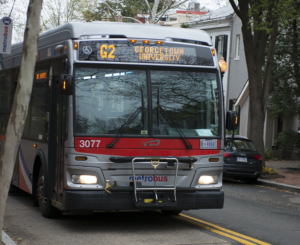The Washington Metropolitan Area Transit Authority plans to make engine changes to address unexpected engine failures that affected two Metrobuses and led to decision that pulled 164 buses from service March 28.
The buses were moving at speeds under 10 mph when the engine failures occurred, causing two people to sustain minor injuries as automatic brakes kicked in to stop the malfunctioning vehicle. While the other 162 buses in the fleet did not show signs of engine failure, concerns about safety led to their removal from service.
“While we have not yet identified a root cause for the two engine stalls, the experts have made recommendations that could reduce the probability of this type of incident in the future,” Joe Leader, WMATA chief operating officer, said in an April 10 statement.
Experts from New Flyer, the manufacturer of the buses, and WMATA have been testing and examining the buses. The buses are relatively new, having been manufactured mostly in 2015-16, and are still under warranty.

While WMATA uses other bus models from New Flyer, the company believes other models are not affected by the malfunction — only buses operating in the Bladensburg Bus division in northeast Washington, D.C., and the Four Mile Bus division in Arlington, Va., may be at risk according to a March statement from WMATA.
One such recommendation Metro plans to implement is increase the “low idle” setting in the engine from 700 rpm to 800 rpm, according to the statement. Experts hope this setting, which is still within manufacturer recommended limits, would reduce the probability of a stall in the future.
A similar problem plagued buses from North American Bus Industries’ hybrid models in 2014, though those concerns have since been identified and resolved.
Testing is continuing with the use of high-tech monitoring equipment on test runs of the buses under regular conditions, though without passengers. If during these trials buses encounter similar engine problems, the equipment will be able to gather data about a failure and inspectors will be able to examine it.
However, if the test runs proceed without incident, Leader said customers could see the buses return to service in the coming weeks.
The fleet of buses removed from service makes up about 10 percent of the Metrobus force. Although about 80 reserve buses have been employed, they do not fully account for the pulled New Flyer fleet. “More than 1 percent of scheduled daily bus trips have not run” since the incidents, and some customers have experienced delays, according to an April 10 WTOP article.
WMATA has clarified that delays resulting from these safety tests will not be subject to its Rush Hour Promise, which guarantees riders who wait for buses that are more than 15 minutes behind schedule.
“While we know that some bus customers have experienced varying degrees of inconvenience as a result of this process, Metro’s commitment to you is that ‘safety trumps service,’” Leader said.




















